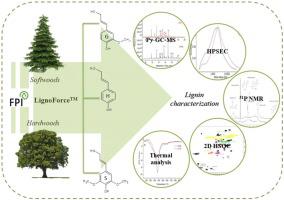Industrial Crops and Products ( IF 5.6 ) Pub Date : 2021-10-13 , DOI: 10.1016/j.indcrop.2021.114138 Maria Juliane Suota 1 , Thiago Alessandre da Silva 1 , Sônia Faria Zawadzki 1 , Guilherme Lanzi Sassaki 2 , Fabrício Augusto Hansel 3 , Michael Paleologou 4 , Luiz Pereira Ramos 1

|
Knowledge about lignin structure after isolation is paramount for demonstrating its potential for industrial applications. This paper presents for the first time the detailed characterization of LignoForce™ hardwood (LFHL) and softwood (LFSL) kraft lignins that were obtained from industrially realistic lignin production facilities. The moisture content was circa 8 % for both LFHL and LFSL, and their total carbon contents were 62.8 and 64.4 %, respectively. Both samples had low ash and carbohydrate contents and total lignin contents higher than 97 %. The macromolecular properties and functional groups of lignin were characterized by nuclear magnetic resonance, analytical pyrolysis (Py-GC–MS), thermal analysis, mass spectrometry, and size exclusion chromatography. LFHL presented lower aliphatic and phenolic OH groups, higher methoxyl content (S/G ratio of 1.97), lower weight-average apparent molecular mass (Mw) and degree of condensation, higher solubility in organic solvents, and lower thermal stability compared to LFSL. C1-Guaiacol and C1-syringol predominated in the Py-GC–MS analyses of LFSL and LFHL, respectively, whose β-O-4′ contents were 5.8 and 6.2 per 100 aromatic units. The high total OH groups of both lignins suggests their suitability for replacing petroleum-based polyols in the preparation of polyurethane foams. LFHL would be preferable in this application due to its higher solubility in the reaction medium. Also, the lower Mw and glass transition temperature of LFHL would facilitate its blending with polymers in thermoplastic applications. LFSL would be a suitable replacement of phenol in phenol-formaldehyde resins, and its higher Mw and improved thermal stability are expected to be useful for making carbon fibers.
中文翻译:

硬木和软木 LignoForce™ 木质素的化学和结构表征
有关分离后木质素结构的知识对于展示其工业应用潜力至关重要。本文首次详细介绍了从工业现实木质素生产设施中获得的 LignoForce™ 硬木 (LFHL) 和软木 (LFSL) 牛皮纸木质素的详细表征。水分含量约为LFHL 和 LFSL 的碳含量均为 8%,它们的总碳含量分别为 62.8% 和 64.4%。两个样品的灰分和碳水化合物含量低,木质素总含量高于 97%。木质素的大分子特性和官能团通过核磁共振、分析热解 (Py-GC-MS)、热分析、质谱和尺寸排阻色谱进行表征。LFHL 具有较低的脂肪族和酚类 OH 基团、较高的甲氧基含量(S/G 比为 1.97)、较低的重均表观分子量(Mw) 和缩合度,与 LFSL 相比,在有机溶剂中的溶解度更高,热稳定性更低。C1-愈创木酚和 C1-紫丁香醇分别在 LFSL 和 LFHL 的 Py-GC-MS 分析中占主导地位,其 β-O-4' 含量为每 100 个芳香单元 5.8 和 6.2。两种木质素的高总 OH 基团表明它们适合在聚氨酯泡沫的制备中替代石油基多元醇。由于 LFHL 在反应介质中的溶解度较高,因此在该应用中将优选使用 LFHL。此外,LFHL较低的Mw和玻璃化转变温度将有助于其在热塑性应用中与聚合物共混。LFSL 将是酚醛树脂中苯酚的合适替代品,其更高的Mw 并且改进的热稳定性有望用于制造碳纤维。











































 京公网安备 11010802027423号
京公网安备 11010802027423号